For an updated perspective on Birth, click here.
I have seen many opinions in regards to this one off. Some like it, some think it’s too weird, some think it’s garbage. I LOVE this OVA and I am out and proud of it. True it is an acquired taste, but I think I may know what turns off some, but also what turn’s me on to this oddity. What is it? Well that little ol’ production from 1984… Birth.
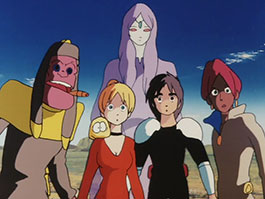 Birth was a title I was lucky to come across very cheaply. Remember when you could get a brand new title off of Amazon for under $4.00? I believe I spent around $3.50 (the glory days of $2.99 shipping). I see it as one of the best return on investments I have ever put into any DVD, because I have watched Birth time after time after time and loved it more each time. And just what is it about Birth that I love so much? I mean it is basically a long chase scene and treasure hunt that ends with the whole universe… whoa wait, don’t want to spoil the ending now. Now… I present my reasons, so read on.
Birth was a title I was lucky to come across very cheaply. Remember when you could get a brand new title off of Amazon for under $4.00? I believe I spent around $3.50 (the glory days of $2.99 shipping). I see it as one of the best return on investments I have ever put into any DVD, because I have watched Birth time after time after time and loved it more each time. And just what is it about Birth that I love so much? I mean it is basically a long chase scene and treasure hunt that ends with the whole universe… whoa wait, don’t want to spoil the ending now. Now… I present my reasons, so read on.
An animator’s playhouse: As someone who has a background, education and interest in art and design I often view certain anime a little differently. In this case I see this property as a fun time for all the animators and staff who worked on it. Very creative, but not serious and artsy fartsy (if you want to go that route try Angel’s Egg). If I could get a gig like this, I would say yes in a heartbeat. Plus Yoshinori Kaneda had a big hand in it’s conception (see recommendations below). So expect lots and lots of motion. Plus, it was animated by one of my favorite, now defunct, smaller animation houses, Kaname Production. Also, Hideaki Anno (Mr. Evangelion) had a hand as well as an up and coming animator.
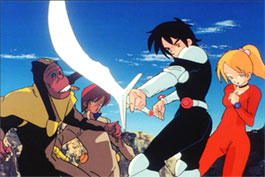 Characters and their design: The design and animation of Birth is very much in contrast to almost a majority of what came out in Japan in the 1980s. The characters are very organic and blob like, maybe a touch liquidy. Is that is why the planet is called Aqualoid? Plus our main cast is a rag tag group. Our main duo, Rasa and Nam, are either brother and sister or boyfriend/girlfriend, in any case they are close and watch out for each other. Boa is a goof ball space trader who has a lolita complex for Rasa. His business partner, Kim, is often the voice of reason in their partnership. Plus you have your array of minor character including the Inorganics, other humans and these blob type things, one of whom belongs to Rasa and is named Monga. (MONGA! MONGA!!!)
Characters and their design: The design and animation of Birth is very much in contrast to almost a majority of what came out in Japan in the 1980s. The characters are very organic and blob like, maybe a touch liquidy. Is that is why the planet is called Aqualoid? Plus our main cast is a rag tag group. Our main duo, Rasa and Nam, are either brother and sister or boyfriend/girlfriend, in any case they are close and watch out for each other. Boa is a goof ball space trader who has a lolita complex for Rasa. His business partner, Kim, is often the voice of reason in their partnership. Plus you have your array of minor character including the Inorganics, other humans and these blob type things, one of whom belongs to Rasa and is named Monga. (MONGA! MONGA!!!)
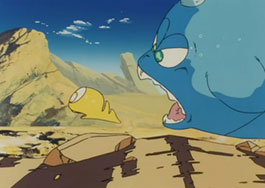 Humor: I find Birth to be amazingly funny. True some of the humor is ridiculous, but it works well for my tastes. I mean you have the scenes where Rasa is called out as a ‘jiggly-butt’ by the Inorganic bikers or they have the comment “Just because a woman is smart does not mean she can sell a cow.” Or, the kid Inorganic hitting on Rasa and after rejection he has a scene at a beach. Or Bao just being Bao. All in all it is weird, spastic and goofy.
Humor: I find Birth to be amazingly funny. True some of the humor is ridiculous, but it works well for my tastes. I mean you have the scenes where Rasa is called out as a ‘jiggly-butt’ by the Inorganic bikers or they have the comment “Just because a woman is smart does not mean she can sell a cow.” Or, the kid Inorganic hitting on Rasa and after rejection he has a scene at a beach. Or Bao just being Bao. All in all it is weird, spastic and goofy.
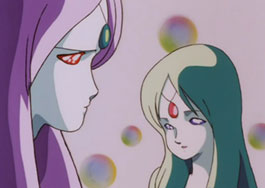 A higher reason: Now how can Birth be deep? Well, the notion of the spirit like Arlia (hey she’s a pretty ghost according to Nam) explaining the universe is made up of several levels and that the Organics and Inorganics are both a product of the same source makes you think twice, what am I really watching here? Even goofy cartoons can add a mind bend. Plus at the ending… oh yeah can’t spoil it if you have not seen it.
A higher reason: Now how can Birth be deep? Well, the notion of the spirit like Arlia (hey she’s a pretty ghost according to Nam) explaining the universe is made up of several levels and that the Organics and Inorganics are both a product of the same source makes you think twice, what am I really watching here? Even goofy cartoons can add a mind bend. Plus at the ending… oh yeah can’t spoil it if you have not seen it.
Music: And finally… the soundtrack… composed by the one and only… Mr. Joe Hisaishi. Oh yeah, Miyazaki’s favorite composer did this one too. It has a similar vibe to what he did on Nausicaa of the Valley of the Wind and Genesis Climber Mospeada. Not very orchestral and more synthesizer and pop/rock in it’s approach.
This is one that I think needs to be viewed in order to have a proper frame of reference. Or having the option of viewing it with someone who is familiar to the property to point things out or hear them chuckle at certain times. As I mentioned above this is an acquired taste, so take what you will from it. If anything this showed the freedom of the era it was produced because we just don’t see this kind of odd ball stuff being released as often anymore, unless there is a huge marketing campaign behind it. As for me if I need to make a top 10 of 80s anime, this is one I would include (honest).

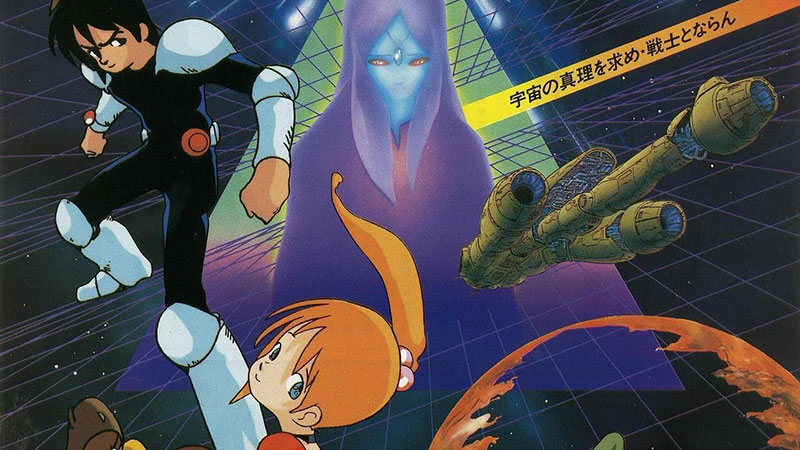

 I see SPT Layzner as a tale of two souls in one body, or perhaps two different, the first part kind of like the original Gundam, kind of, while the second is a mech show that takes many design cues from Fist of the North Star (showing the popularity of this Shonen Jump series). But at it’s genesis, SPT Layzner is a sci-fi mecha series that is told in the ‘future’, the ‘future’ of 1996. Well 1996 was the ‘future’ when the show aired in 1985. Not only that, but the Soviet Union never fell either and the Cold War continued well into the 1990s. If none of this rings a bell I suggest a quick run to your local library’s history section (we are here to talk anime my people). With high political and military tension in the air, what would be more perfect than to have an alien human race come to our solar system and attempt a take-over during all this? And guess what? We get just that.
I see SPT Layzner as a tale of two souls in one body, or perhaps two different, the first part kind of like the original Gundam, kind of, while the second is a mech show that takes many design cues from Fist of the North Star (showing the popularity of this Shonen Jump series). But at it’s genesis, SPT Layzner is a sci-fi mecha series that is told in the ‘future’, the ‘future’ of 1996. Well 1996 was the ‘future’ when the show aired in 1985. Not only that, but the Soviet Union never fell either and the Cold War continued well into the 1990s. If none of this rings a bell I suggest a quick run to your local library’s history section (we are here to talk anime my people). With high political and military tension in the air, what would be more perfect than to have an alien human race come to our solar system and attempt a take-over during all this? And guess what? We get just that. Just before this maelstrom, we begin our story with a group of students and their teacher making there way to Mars as part of an effort to foster the peace of the Earth. These students get caught up into the upcoming hell of the Gradosian invasion losing a majority of their classmates and friends. Upon seeing so much death and destruction these kids catch a glimpse of a blue robot fighting against these invaders not really sure who this lone fighter is. And it is from this robot we meet it’s pilot, a terrified, confused, but bravely determined young man Eiji Asuka (Null Alberto) voiced by one of my fav seiyu, Kazuhiko Inoue. His warning of this invasion is met with caution and hatred as he is one of them, a Gradosian. How can he prove his authenticity and trust? Only time will tell as these students struggle to survive with this new ally.
Just before this maelstrom, we begin our story with a group of students and their teacher making there way to Mars as part of an effort to foster the peace of the Earth. These students get caught up into the upcoming hell of the Gradosian invasion losing a majority of their classmates and friends. Upon seeing so much death and destruction these kids catch a glimpse of a blue robot fighting against these invaders not really sure who this lone fighter is. And it is from this robot we meet it’s pilot, a terrified, confused, but bravely determined young man Eiji Asuka (Null Alberto) voiced by one of my fav seiyu, Kazuhiko Inoue. His warning of this invasion is met with caution and hatred as he is one of them, a Gradosian. How can he prove his authenticity and trust? Only time will tell as these students struggle to survive with this new ally. Now I will be very, very biased here, but I think the SPT-LZ-OOX is perhaps the best mecha design ever (by the way SPT stands for Super Powered Tracer). It’s small, sleek and sexy, but very functional. Almost like a great sports car or rally racer. And it’s BLUE, beautiful blue. A Gundam, Ingram, Scopedog, Valkyrie, or your odd assortment of super robots also have their merits and are great, but the Layzner for me is personal. That is what I am looking for on the showroom floor. I wonder if you can downhill it like in Initial D? Hey… wasn’t there a guy in Initial D named Ryosuke Takahashi (Layzner’s director if you didn’t know)? Makes you wonder?
Now I will be very, very biased here, but I think the SPT-LZ-OOX is perhaps the best mecha design ever (by the way SPT stands for Super Powered Tracer). It’s small, sleek and sexy, but very functional. Almost like a great sports car or rally racer. And it’s BLUE, beautiful blue. A Gundam, Ingram, Scopedog, Valkyrie, or your odd assortment of super robots also have their merits and are great, but the Layzner for me is personal. That is what I am looking for on the showroom floor. I wonder if you can downhill it like in Initial D? Hey… wasn’t there a guy in Initial D named Ryosuke Takahashi (Layzner’s director if you didn’t know)? Makes you wonder?
 Megazone 23 could be my favorite one off OVA of all time. True there are two other parts, well three since part three is a two-parter. Megazone 23, the first one, the original, is in my mind enough
Megazone 23 could be my favorite one off OVA of all time. True there are two other parts, well three since part three is a two-parter. Megazone 23, the first one, the original, is in my mind enough  Megazone 23 is far from the first anime I was exposed to, but I can say for sure it was the first that solidified me as an otaku. Before Megazone 23 I had a good working knowledge of well known titles at the time and that I was aware of: Robotech, Gundam Wing, Akira, Ghost in the Shell, Record of Lodoss War… you get the picture. Mostly well known popular stuff, quasi-casual may be a better term. I needed to locate more niche material. So I landed on Megazone 23 and Area 88, not a bad combination if I say so.
Megazone 23 is far from the first anime I was exposed to, but I can say for sure it was the first that solidified me as an otaku. Before Megazone 23 I had a good working knowledge of well known titles at the time and that I was aware of: Robotech, Gundam Wing, Akira, Ghost in the Shell, Record of Lodoss War… you get the picture. Mostly well known popular stuff, quasi-casual may be a better term. I needed to locate more niche material. So I landed on Megazone 23 and Area 88, not a bad combination if I say so. Begun as a so called follow-up to a show most Robotech fans should be familiar with, Genesis Climber Mospeada, Megazone 23 had an interesting start. I often consider this show to be the true sequel to Macross (another nod to Robotech), if not in name, as it shares a majority of it’s key staff including director Noboru Ishiguro and character designers Toshihiro/Toshiki Hirano and Haruhiko Mikimoto (three men I have the highest of respect for). I won’t get into the historic details too much, but the production started off as a TV series with various working titles until the main sponsor pulled the plug. No money, big problem, what to do? Release it direct to video since that is a growing market and thankfully, that is what happened. Who knows how much of the plot was cut to fit it into an approximate 80 minute running time? But in the end who cares, it worked.
Begun as a so called follow-up to a show most Robotech fans should be familiar with, Genesis Climber Mospeada, Megazone 23 had an interesting start. I often consider this show to be the true sequel to Macross (another nod to Robotech), if not in name, as it shares a majority of it’s key staff including director Noboru Ishiguro and character designers Toshihiro/Toshiki Hirano and Haruhiko Mikimoto (three men I have the highest of respect for). I won’t get into the historic details too much, but the production started off as a TV series with various working titles until the main sponsor pulled the plug. No money, big problem, what to do? Release it direct to video since that is a growing market and thankfully, that is what happened. Who knows how much of the plot was cut to fit it into an approximate 80 minute running time? But in the end who cares, it worked. Being the fact that this production was released direct to video, it gave those who grew up with mecha as their preferred genre an even more “realistic” grown up story following the growing sophistication of epics like Gundam, Macross and Votoms. Of course the growing popularity of the fighting genre (Fist of the North Star, Dragon Ball and Saint Seiya) signaled an end to the television dominance of mecha. Zeta Gundam, also a 1985 release, is in my mind the capstone to an era in television where mecha grew in sophistication and serious subject matter that did not come back again until possibly Evangelion. Many of those who grew up in the 70s/early 80s now needed a new avenue to find material and in many cases material to match their growing maturity. Megazone 23 was in the perfect place at the perfect time.
Being the fact that this production was released direct to video, it gave those who grew up with mecha as their preferred genre an even more “realistic” grown up story following the growing sophistication of epics like Gundam, Macross and Votoms. Of course the growing popularity of the fighting genre (Fist of the North Star, Dragon Ball and Saint Seiya) signaled an end to the television dominance of mecha. Zeta Gundam, also a 1985 release, is in my mind the capstone to an era in television where mecha grew in sophistication and serious subject matter that did not come back again until possibly Evangelion. Many of those who grew up in the 70s/early 80s now needed a new avenue to find material and in many cases material to match their growing maturity. Megazone 23 was in the perfect place at the perfect time.
You must be logged in to post a comment.